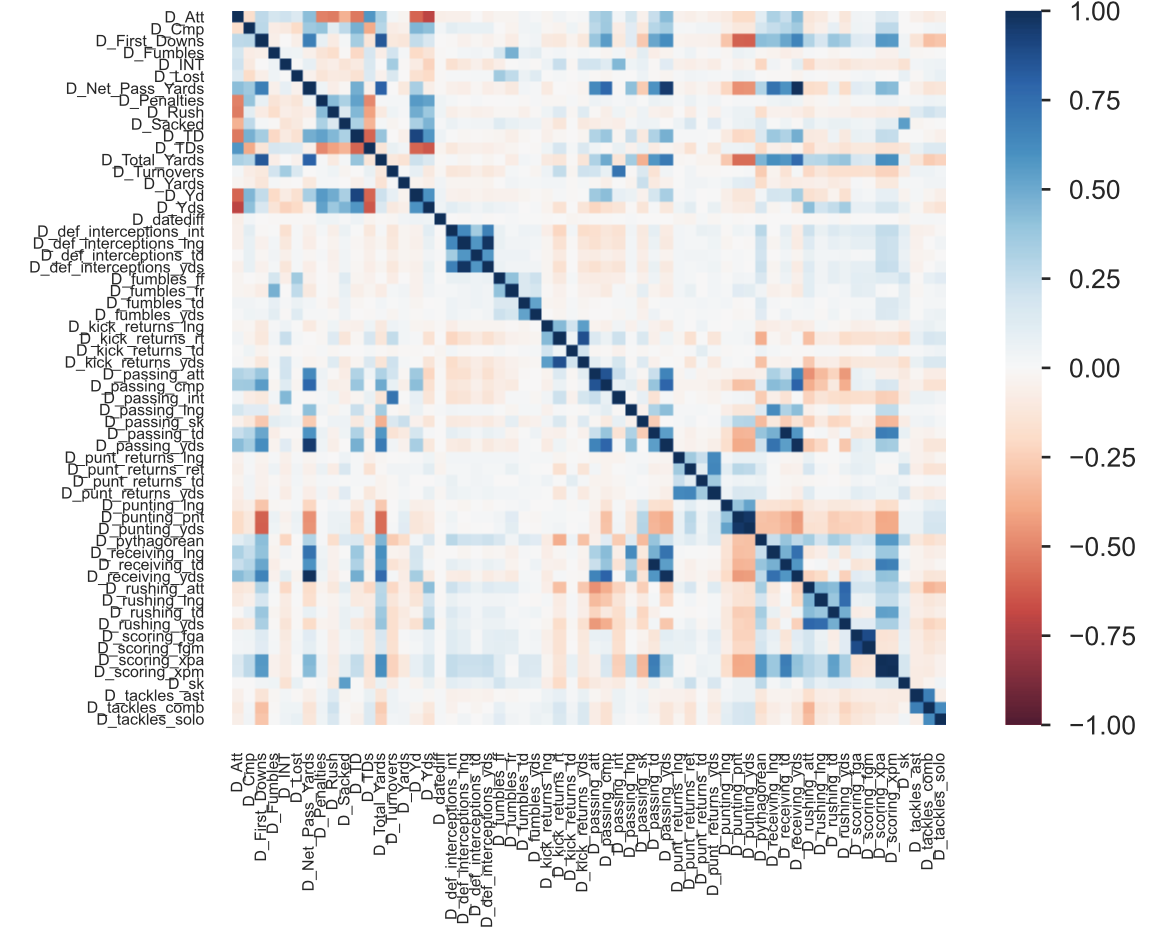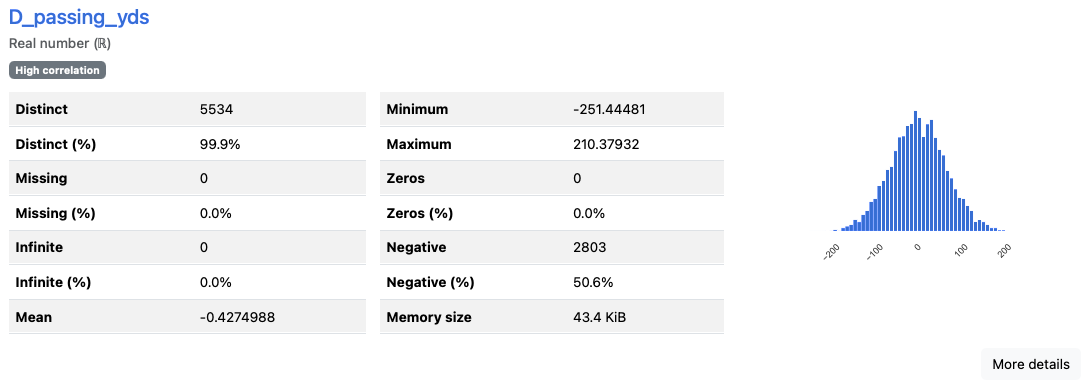NFL Sports Prediction Part 2: Exploratory Data Analysis via ydata_profiling
Part 2 - Exploratory Data Analysis via ydata_profiling
Column definitions
cont_cols = [
'D_datediff', # Days since last game (Home - visitor)
# first downs
'D_First_Downs',
# Basic Stats
'D_Rush', # Number of running plays attempted
'D_Yds', # Yards gained through running plays
'D_TDs', # Touchdowns scored via running plays
'D_Cmp', # Completions (# of successful passes)
'D_Att', # Attempts (# of passes thrown, completed or not)
'D_Yd', # Yards (Yards the passes have covered)
'D_TD', # Touchdowns
'D_INT', # Interceptions
'D_Sacked', # Number of times quarterback was tackled behind line of scrimmage
'D_Yards', # Yards lost from sacks
'D_Net_Pass_Yards', # Net passing yards (total yds - yards lost due to sacks)
'D_Total_Yards', # Total yards gained (net pass yards + rushing yds)
'D_Fumbles', # Number of times ball was fumbled
'D_Lost', # Number of times the team lost possession of the ball due to a fumble
'D_Turnovers', # Total number of turnovers, includes interceptions & fumbles lost
'D_Penalties', # Number of penalties committed by the team
# Passing Detailed
'D_passing_att', # Passes attempted
'D_passing_cmp', # Passes completed
'D_passing_int', # Interceptions thrown
'D_passing_lng', # Longest completed pass
'D_passing_sk', # Passing times sacked
'D_passing_td', # Passing touchdowns
'D_passing_yds', # Yards gained by passing
# Receiving
'D_receiving_lng', # Longest reception
'D_receiving_td', # Receiving touchdowns
'D_receiving_yds', # Receiving yards
# Rushing Detailed
'D_rushing_att', # Rushing attempts (sacks not included)
'D_rushing_lng', # Longest rushing attempt (sacks not included)
'D_rushing_td', # Rushing touchdowns
'D_rushing_yds', # Rushing yards
# Defense interceptions
'D_def_interceptions_int', # Passes intercepted on defense
'D_def_interceptions_lng', # Longest interception returned
'D_def_interceptions_td', # Interceptions returned for touchdown
'D_def_interceptions_yds', # Yards interceptions were returned
# Defense fumbles
'D_fumbles_ff', # Num of times forced a fumble by the opposition recovered by either team
'D_fumbles_fr', # Fumbles recovered by player or team
'D_fumbles_td', # Fumbles recovered resulting in touchdown for receiver
'D_fumbles_yds', # Yards recovered fumbles were returned
# Defense tackles
'D_sk', # Sacks
'D_tackles_ast', # Assists on tackles
'D_tackles_comb', # Solo + ast tackles
'D_tackles_solo', # Tackles
# Kick Returns
'D_kick_returns_lng', # Longest kickoff return
'D_kick_returns_rt', # Kickoff returns
'D_kick_returns_td', # Kickoffs returned for a touchdown
'D_kick_returns_yds', # Yardage for kickoffs returned
# Punt Returns
'D_punt_returns_lng', # Longest punt return
'D_punt_returns_ret', # Punts returned
'D_punt_returns_td', # Punts returned for touchdown
'D_punt_returns_yds', # Punts return yardage
# Punting / Scoring
'D_punting_lng', # Longest punt
'D_punting_pnt', # Times punted
'D_punting_yds', # Total punt yardage
'D_scoring_fga', # Field goals attempted
'D_scoring_fgm', # Field goals made
'D_scoring_xpa', # Extra points attempted
'D_scoring_xpm', # Extra points made
# Additional, calculated metrics
'D_pythagorean', # NFL variation of Bill James pythagorean expectation (from wikipedia)
]Categorical columns
There are no categorical columns to handle in this dataset.
Missing values
Skipping this since it’s not necessary based on how the D_ columns are composed. This is more effective earlier on. It may be helpful to check.
Skewness
I set the skewness alert to fire when > 1. No columns exceeded this range. Otherwise, the skewed columns would have to be handled so it turns into a more normal distribution. Here is a helpful guide I found on kaggle regarding this
Observing the correlation matrix & removing strikingly similar columns
Using the correlation matrix, we can reduce the total number of columns by simply identifying columns that are striking similar to each other.

I selected the columns to retain based on my best judgment. The bold & highlighted cells will be preserved and the rest will be ignored.
| Similar column 1 | Similar column 2 | Similar column 3 |
|---|---|---|
| D_Net_Pass_Yards | D_passing_yds | D_receiving_yds |
| D_def_interceptions_lng | D_def_interceptions_yds | |
| D_passing_td | D_receiving_td | |
| D_scoring_fgm | D_scoring_fga | |
| D_scoring_xpm | D_scoring_xpa | |
| D_punting_pnt | D_punting_yds |
Through this analysis, we are dropping 7 columns: D_passing_yds, D_receiving_yds, D_def_interceptions_lng, D_receiving_td, D_scoring_fga, D_scoring_xpa, D_punting_pnt
Reducing sig figs
Since an EMA is applied to the majority of columns, these columns ended up containing a 4 or more sig figs. This was observed by looking at the min & max values among items with a high distinct percentage. I decided to restrict the results to 3 sig figs.
Note that this won’t be necessary if I apply a standard scaler (helpful for an ANN), however I’m applying it anyway for the second ydata_profiling run.
Observe D_passing_yds:

You’ll find this post in your _posts directory. Go ahead and edit it and re-build the site to see your changes. You can rebuild the site in many different ways, but the most common way is to run jekyll serve, which launches a web server and auto-regenerates your site when a file is updated.
Jekyll requires blog post files to be named according to the following format:
YEAR-MONTH-DAY-title.MARKUP
Where YEAR is a four-digit number, MONTH and DAY are both two-digit numbers, and MARKUP is the file extension representing the format used in the file. After that, include the necessary front matter. Take a look at the source for this post to get an idea about how it works.
Jekyll also offers powerful support for code snippets:
def print_hi(name)
puts "Hi, #{name}"
end
print_hi('Tom')
#=> prints 'Hi, Tom' to STDOUT.Check out the [Jekyll docs][jekyll-docs] for more info on how to get the most out of Jekyll. File all bugs/feature requests at [Jekyll’s GitHub repo][jekyll-gh]. If you have questions, you can ask them on [Jekyll Talk][jekyll-talk].